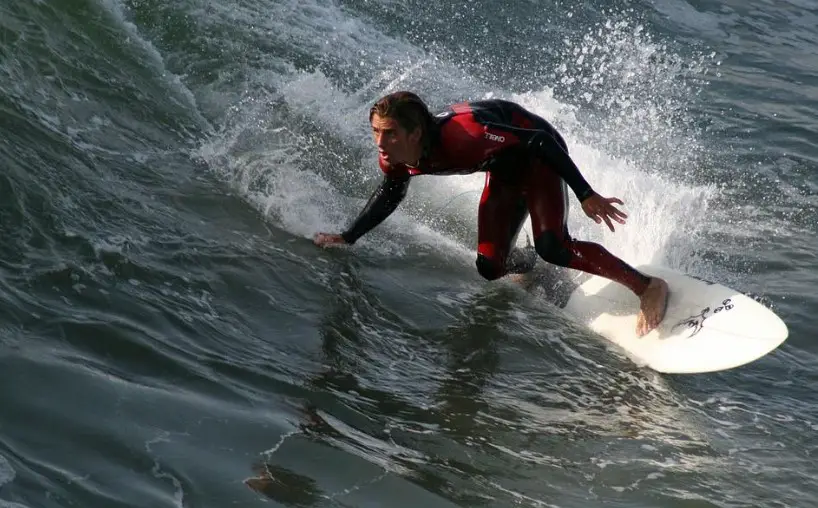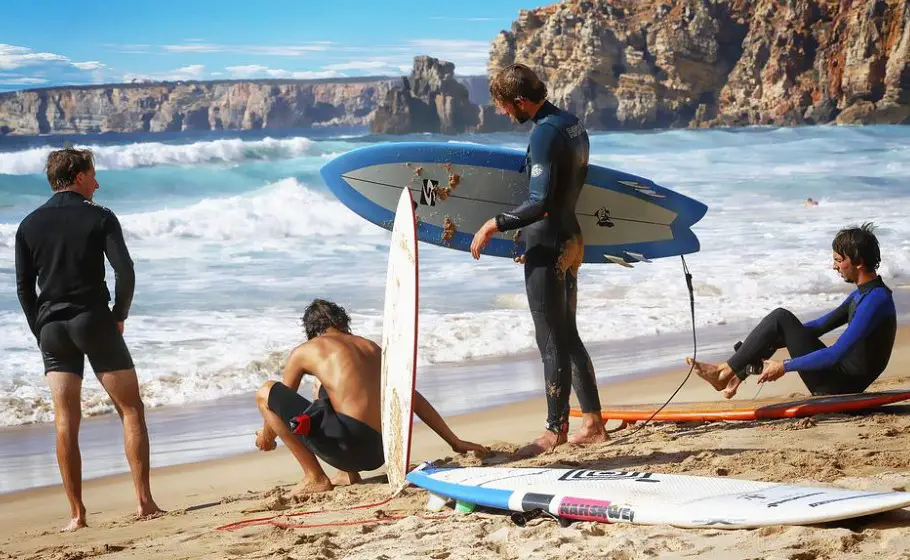Surfers opt for T-shirts due to comfort and the local climate. Rash guards provide better sun protection, preventing chafing and board rash. However, T-shirts are more breathable and accessible. In warm areas, 80-90°F (27-32°C), T-shirts offer flexibility and cooling, though less UV protection.
Why Do Surfers Wear T-shirts When They Surf Instead of a Rash Guard?
Riding the waves on a surfboard is an exciting mainstream water sport. It not only demands skill and balance but also requires surfers to equip themselves with proper surfing gear. Amongst this gear, a common question arises: why do some surfers wear t-shirts instead of a rash guard? Here are several reasons for this preference.
1. Cost-Effectiveness
T-shirts are often cheaper than rash guards, making them an attractive choice for beginners who can’t yet invest in a more expensive rash guard.
2. Availability and Accessibility
T-shirts are readily available in most retail outlets and are not as specialized as rash guards. This convenience makes it more preferable for some surfers.
3. Comfort and Mobility
Some surfers find wearing a t-shirt more comfortable than a rash guard, especially for long hours on the beach. The loose-fitting nature of t-shirts provides a sense of freedom and added mobility.
4. Personal Taste and Fashion
Surfers often like to incorporate their sense of style with their surf attire. Wearing a t-shirt allows them to showcase their fashion preference while enjoying their day of surfing.
5. Rash guards can get too hot
Rash guards, though they protect against rashes and sunburns, can often get too hot. T-shirts, being made mostly of cotton, can thereby be more comfortable and breathable.
6. Adjustability
While rash guards are usually one size fits all, t-shirts are more adjustable as they come in a variety of sizes.
| Reasons | T-shirt | Rash guard |
|---|---|---|
| Cost | Less expensive | More expensive |
| Availability | More accessible | More specialized |
| Comfort | More comfortable for some surfers | May be less comfortable for prolonged periods |
| Style | More variety | Limited options |
| Heat | Less hot | May get hotter |
| Adjustable Sizes | More sizes | Usually one size fits all |
It’s important to note that while each holds its distinctive advantages, most professional surfers and surfing schools recommend wearing specialty surfing attire such as rash guards due to their design aimed at protection against the elements, reduction in the incidence of surf rash, and durability. However, personal preference often plays a role in determining whether a surfer wears a t-shirt or a rash guard.
Rash Guards vs. T-shirts: Which Is Better?

Surfing is a sport that can get you into some serious trouble if you’re not prepared for it. For a long time, most people in the water will eventually get some rash or other skin infection from being exposed to too much salt water.
Sports shirts can also be very different from rash guards. Manufacturers design sports shirts intending to help athletes avoid injuries, while others provide extra warmth and protection against sunburns, much like a basic swim shirt.
Rapid impact with surface water and waves causes skin irritation, but rash guards help to prevent the irritation.
Consider your hobbies if you are unsure which of these two scenarios is most appropriate for your lifestyle or what kind of designs appeal to you. Sports shirts tend to be lighter than their counterparts but still function similarly in keeping one safe from sun damage during outdoor activities such as surfing or snowboarding.
A t-shirt feels more comfortable when worn because it does not restrict movement on the neck and armpits due to how loose they become, unlike a rash guard that causes pain if worn too tightly over an extended period.
Comprehension garments help support muscles and increase blood flow, improving performance. Comprehension shirts for competitive surfing are nearly always skin-tight. In contrast, rash guards can have a more relaxed fit, so they’re usually better suited to protect the skin from sun, sand, or even surfboards rather than supporting a sports performance.
For people not interested in competing in pro-level sports like surfing or swimming, where comparison is essential, swim shirts generally offer more comfort than rash guards. They don’t have as much comprehension woven around them that would create pinching sensations on the body when clothes get wet during physical activity.
6 Crucial Surfing Tips

1. Learn the Basics before You Go Too Far
Before you head out into the ocean and start surfing, you’ll need to learn the basics. Learning the basics allows you to get used to the water feel, water movement, and the board before you’re out on your board. Learn the skill of standing up on a board, balance, and build strength and stamina by paddling around in the shallows.
Before you go out on your board for the first time, make sure you’re paddling around with an instructor. This way, you’ll get used to getting up on a board, paddling around, and getting used to the feel of the water without risking any severe injuries.
You’ll want to know where the waves are consistent. You’ll also want to get some basic surfing skills and theory. You’ll know a lot more once you get on board and start surfing, although you need to start with some fundamentals that will help you feel for the sport and make you confident.
One of the best ways to learn the basics is through private lessons from a skilled instructor. These lessons will help you learn how to surf safely and get caught up on the basics in a safe way for you and convenient for your instructor.
2. Buy a Good Board and Wetsuit
Suppose you choose to give surfing a try; you’ll need to buy a surfboard and wetsuit to get started. While you can rent a board and wetsuit from a facility, you’ll likely rent them often over your learning course. Since they’re so pricey, it is better to purchase than rent.
Choosing from a wide range of boards and wetsuits, you can plan what to do in the water depending on your skill level. If you’re starting, choose a lightweight board that’s easier to maneuver in the water.
As you get comfortable, you can choose to upgrade to a heavier board, which allows you to travel further and catch more giant waves.
Suppose you plan to surf in cold water; consider investing in a wetsuit. Choose a full-body wetsuit or purchase arms and legs separately.
3. Stay Hydrated
Remember, it is essential to stay hydrated when surfing. The sport is challenging and leaves you feeling overheated, especially if you don’t wear a wetsuit. Ensure to stay hydrated during your surfing sessions. Do this by bringing along a water bottle, drinking water during your session, or investing in a hydration pack wearable on your back. Another way to stay hydrated is by drinking lots of water before you head out to the beach.
4. Surfing Requires Lots of Physical Fitness
Another challenge with surfing is that it’s a physically challenging sport. It would be best to be in great shape, physically strong, and fit to surf. You can’t show up at the beach and start surfing without heading out to the water.
You’ll also need to properly stretch before heading out to surf and make sure you have a wetsuit that fits your body type. It will help you stay safe in the water and prevent any rash injuries.
5. Don’t Try to Take on Waves You Can’t Overcome
In addition to being a physically challenging sport, surfing is dangerous. Even experienced surfers get injured if they aren’t careful. It is essential to stay safe and not try to take on waves that you can’t safely get on.
Ensure to try to respect the ocean and the environment. Don’t throw garbage into the water, don’t litter, and don’t do anything that will negatively impact the ocean and those who love to use it.
6. Ensure You Have Insurance
Ensure to have insurance before hitting the water. It is important because the moment something happens while surfing, you want to ensure you get help and get out safely. For example, if you’re surfing and get into a rip current and get pulled out to sea, you’ll want to ensure you have someone to help you back out.
There are plenty of things that can go wrong, so you need to be prepared. You should have insurance in place for your activities, and it will protect you if something happens and help you get out without spending a fortune on a claim.
References:
https://www.quora.com/Why-do-surfers-wear-tshirts-when-they-surf-instead-of-a-rash-guard
https://surfmentor.com/why-do-surfers-wear-shirts-while-competing/

